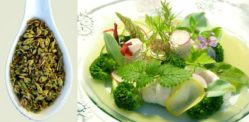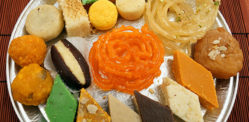Using the right herbs in a dish can make the difference
Herbs have been a major ingredient in cooking around the world and many have originated in middle and eastern cultures.
Popular herbs can help with taste and health.
More and more herbs today are being promoted as vital ingredients in your cooking.
So, how do we know which ones to use and which also will be beneficial not just for taste but for our health too?
To find out the answers let”s look at some of the popular herbs used in dishes.
BASIL

It also works very well with onions, garlic and olives. The leaves of this herb may taste like anise, with a strong, pungent and often sweet smell.
Basil is often used with other herbs like Oregano and Sage in dishes. For the most intense flavour, it should be added at the end of the cooking process.
Prolonged heat will cause Basil”s volatile oils to dissipate.
Always try and use fresh basil because you will never get full flavour when using dried basil. So, if using dried, as a guide one tablespoon of fresh chopped basil is equal to one teaspoon dried.
Basil is said to be a tonic and calms the nervous system, it may aid digestion and stomach cramps and basil tea can help relieve nausea.
BAY LEAF

Originating in Asia Minor, it was not introduced to England until the sixteenth century. Today, it is one of the most widely used culinary herbs in Europe and North America.
The herb has a distinctive, sharp and bitter taste and can be used as a whole leaf, dried, crushed or ground for cooking.
Bay is one of the herbs that can be put into an Italian sauce or Indian curry in the beginning and left in for the entire simmering process.
It is also an ingredient in the South Asian spice Garam Masala.
For European cooking, it is part of the herbal seasoning bouquet garni, which is a combination of herbs tied together with string.
The Bay leaf is known to stimulate and aid digestion.
CORIANDER

Historically, Coriander seems to have been cultivated in Greece since at least the second millennium BC.
Fresh chopped coriander leaves are used as a garnish immediately before serving South Asian dishes because heat diminishes their flavour.
The leaves spoil quickly when removed from the weed, and lose their aroma when dried or frozen.
The fresh leaves are also used an ingredient in Chinese dishes, Mexican cooking, particularly in salsa and guacamole and as a garnish, and in salads in Russia.
Both the seeds and leaves of Coriander are used for aiding the urinary tract and treating infections in this area.
DILL

In India, dill is known as “Savaa” in Hindi or “Soa” not related to Soy, in Punjabi.
The flavor of Dill weed diminishes greatly the longer it is cooked. Add it at the last minute for full flavour and aroma.
Conversely, heating brings out the aroma of Dill seed, so toasting in a hot frypan before using help bring out the best in flavour.
It is prepared in the manner of yellow Moong daal as a main-course Indian dish.
In Middle Eastern dishes the herb is used in cold dishes, pickles and with fish.
Dill is known for its effectiveness to relieve flatulence and other gastric issues, and often served as an after meal digestive.
FENNEL

The leaves are delicate and flavoured. The bulb is a crisp, hardy vegetable and maybe sautéed, stewed, braised, grilled, or eaten raw.
Dried fennel seed is an aromatic anise-flavoured spice.
Fennel features prominently in Mediterranean cuisine, where bulbs are used, both raw and cooked, in side dishes, salads, pastas, vegetable dishes and risottos.
Fennel seed is a common ingredient in Italian sausages and meatballs and northern European rye breads.
In many parts of India and Pakistan, known as “Saunf” roasted fennel seeds are consumed as mukhwas, an after-meal digestive and breath freshener.
In India, fennel seeds are also eaten raw, sometimes with some sweetener, as they are said to improve eyesight.
Fennel is known for its properties to help with digestion and prevent excessive insomnia, nausea and vomiting.
OREGANO

It is very popular in Italian cooking especially in pasta sauces, on pizzas and frequently used with roasted, fried or grilled vegetables, meat and fish.
The herb is also widely used in Turkish, Palestinian, Lebanese, Egyptian, Syrian, Greek, Portuguese, Spanish, Philippine and Latin American cuisines.
It is particularly full of flavour when dried and combines well with spicy foods.
Leaves are most often used in salads especially, Greek salads.
Oregano is known to relieve the symptoms of colds, flu and coughs but must not be used medicinally during pregnancy.
SAGE

It has a strong distinctive flavour and aroma so needs to be used sparingly.
It is often combined with other herbs, mainly Thyme in dishes.
Sage blends well with mild cheeses and is commonly used as a key ingredient for a stuffing mix, used for many meat roasts.
Dried sage is preferred by most cooks and comes in whole leaf, rubbed, and ground form. Fresh leaves may be covered in olive oil and stored in the fridge for up to three weeks.
It is one herb that freezes well.
Sage can help with indigestion, anxiety and excessive sweating. It can help ease sore throats if used as a part of a gargle mixture.
THYME

The herb is a key ingredient in many cuisines including Lebanese, Israeli, Italian, French, Persian, Portuguese, Spanish, Greek, Caribbean, Indian and Turkish dishes.
Thyme is often used to flavour meats, soups and stews. It is often used as a primary flavour with lamb, tomatoes and eggs.
It does not overpower and blends well with other herbs and spices.
Thyme can be bought both fresh and dried. The fresh version is full of more flavour but also has a storage life of rarely more than a week.
Thyme has been known to be useful to treat coughs and catarrh.
MINT
The history of Mint goes back to the Greek times and Romans are known to be responsible for carrying the herb throughout Europe.
It is a herb common to South Asia, especially as a chutney. The plant is called “Pudina” in Punjabi.
Mint is ideal for soups, salads, sauces, meats, fish, poultry, stews, chocolate dishes and lemony desserts.
It is used widely to flavour dishes with its distinct pungent taste. For meat dishes, it goes well with Lamb. Also, it is popular as a herbal tea.
Mint aids indigestion, irritable bowel syndrome and can help with reducing colds. Pudina is also well known for its use as a mouth and breath freshener.
CURRY LEAVES
Curry leaves belong to the “Curry Tree” which is a small tree, growing 4–6 m tall, with a trunk up to 40 cm in diameter.
Curry leaves are highly valued as seasoning in southern and west-coast Indian cooking, and Sri Lankan cooking. Especially in curries, usually fried along with the chopped onion in the first stage of the preparation.
Curry leaves tend to lose their delicate fragrance when dried. Therefore, try to obtain them fresh.
They are known to have anti-cancer properties, helping with stomach disorders and constipation, and are even used to promote hair growth and reduce grey hairs.
There are many more herbs that are available for use in cooking or medicinal purposes and every one of them has its own properties.
So, don”t be afraid to explore the use of herbs in your cooking because they can add a distinct flavour to a dish and make it a hit for your taste buds.































































